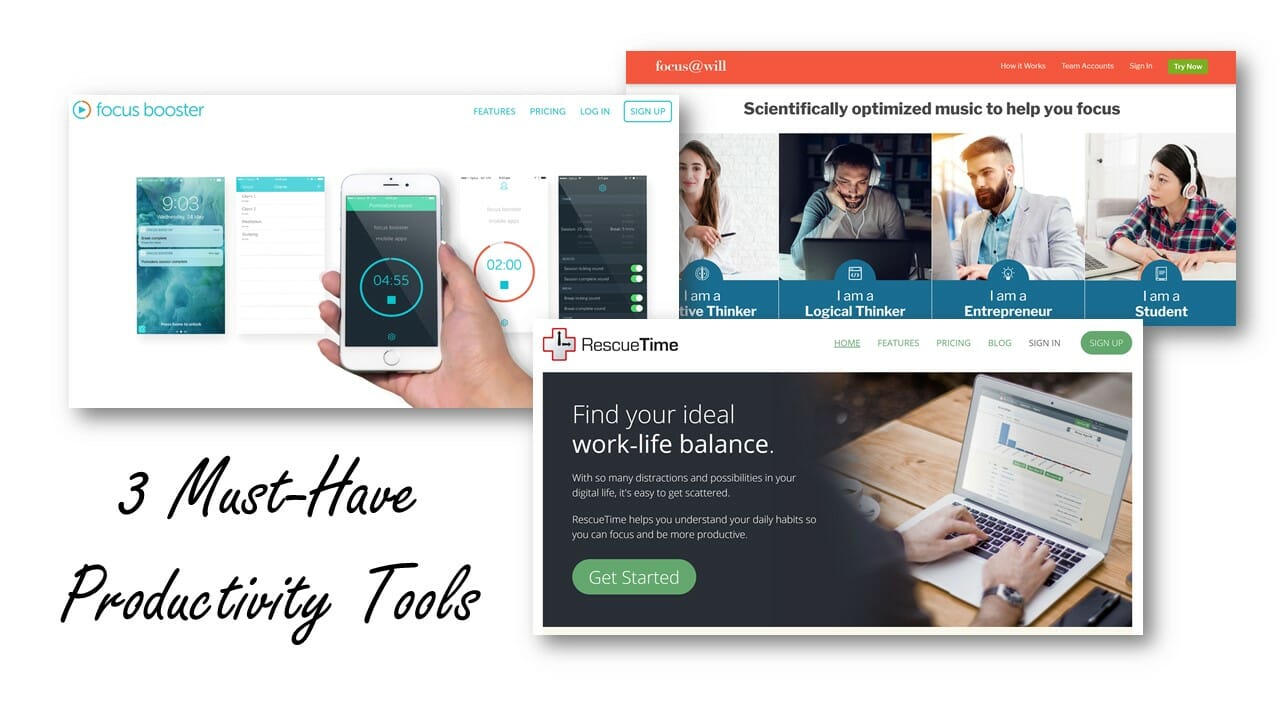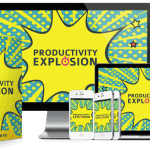
3 Productivity Tools to Reach Your Goals Faster
If you’re like most busy people, you’re always looking for ways to increase your productivity. If you can find a way to:
* Limit distractions in this distraction-filled world
* Stay focused on a single task at a time
…you’re well on your way to getting more done, but it’s not always easy to get there. Well, thanks to the amazing technology we have available to us today, there are a plenty of tools out there that can help .
Here are 3 of our favorite productivity tools to help you limit distractions and stay focused.
#1: Rescue Time https://www.rescuetime.com/

Let’s get the distractions out of the way first because even while technology brings us so many great productivity tools, it also brings us tremendous distractions. RescueTime helps you track your time on your computer and your mobile devices and identifies where you where you’re spending (ahem…often wasting) a lot of your time.
RescueTime will:
Alert you when you’re spending a certain amount of time on an activity
Allow you to block distracting websites during focus time
Keep track of what you accomplished throughout the day
Identify how much time you spend on a variety of activities, including email, meetings, etc.
You can sign up for a Lite account, which is completely free or their premium service for added features.
#2: Focus Booster Pomodoro App https://www.focusboosterapp.com/

The Focus Booster app is based on the Pomodoro Technique, which is a long-standing productivity technique that uses a timer for focused work periods, usually 25 minutes, followed by a break of 3-5 minutes. After you complete 4 work periods, you get a break of 15-30 minutes. The idea is you stay completely focused on the task during the work period.
There are a lot of apps that can help you execute the Pomodoro Technique, but you can check out Focus Booster. The app is free for up to 20 sessions per month or you can pay a reasonable yearly fee for unlimited sessions and extra features.
The app keeps a time sheet for you and produces a report that allows you to track your productivity and identify ways to become even more productive.
#3: Focus @ Will https://www.focusatwill.com/

Now here’s something very different, but scientifically proven to increase focus and productivity. And if you love music, this is going to be great news for you.
Focus@Will uses human neuroscience and music to help you focus, limit distractions, get productive and retain more information. All you do is answer a few questions and the software will determine the right music to put your brain in a flow state that makes you super productive.
There is a free 2 week trial, so you can see if it works for you.
Try these tools and let us know what you think. And hey, if you’ve got a productivity tool you love, can you post it in the comments below? We’d love to gather up your answers and make part 2 for this article with more great productivity tools.
4 Step Goal Setting Strategy
Everyone has certain goals they want to reach. It might be weight loss or finances in your personal life, or specific business growth goals in your career. Regardless of what milestones you want to achieve, you won’t get there if all you have is the end result in mind.
Setting goals is just one part of the equation. Knowing how to get there is the piece of the puzzle that so many people leave out, which leads them to flounder, procrastinate and veer off course until one day they realize they’re completely off base and have wasted a lot of time and effort.
There are four easy steps you can take to ensure your goals are met. It’s a process that allows you to map out where you want to be and take steps to get there with ease.
Step 1 – Know Your End Result
In order to know what steps you need to take, you have to know how you’d like your journey to end. This is your outcome or end result. You have to be able to concretely define what you want that result to be.
This is the bottom line of everything that you’re attempting to do. Many people aim for something without ever knowing what they want the end result to be. The problem with not knowing your end goal is that you won’t realize it once you’ve reached it – if you even reach it at all.
Let’s say that you take up running for the exercise. Your end result could be to lose weight or get in better shape. Now let’s say that you set a more specific goal to take up running because you want to run in a marathon that’s happening in the future.
Your end result changed from a generic goal of losing weight and getting in better shape to the end result of competing in the marathon, which has a specific length and is on a specific timetable.
Only you will be able to determine your end goal. It might be to finish college, grow your business by $50,000 in the coming year, lose 25 pounds, and so on. Have a large, verifiable goal to reach.
Knowing the end result is imperative for whatever it is that you want in life. You need to know this to be able to work your process. This might mean that you figure out different end results for different areas of your life.
It’s okay to have one for the personal side of your life for relationships and things like that while having another one for your professional goals. Don’t just say, “I want to be happier.”
What would make you happier, specifically? Visualize that end goal that you want. For now, don’t worry about timing. You’ll be working on that as you develop your specific goal setting strategy.
Step 2 – Craft Mini Goals
Goals are something that can be used to improve your life. By having goals, you can check to see if you’re on track for how you want your life to turn out. Goals are helpful tools that can keep you headed in the right direction when you need to make a decision that involves changing some aspect of your life.
Encouragement is a by-product of having goals. Whenever you have a setback, goals can encourage you to keep going. By seeing how far you’ve already come, you realize that you’ve already made some strides forward.
Most success-minded people will focus on short-term goals over long-term goals because these are easier to make come true. Living in a results-oriented world causes people to lean toward short-term goals more often.
Dreamers who do very little action taking often focus on long-term goals, forgetting that they need a specific path to get them there. They stay paralyzed, feeling the long-term goal is too far out of reach.
Having short-term goals means that these are things that you do in the present or in the very near future – such as within a week or a month. An example of a short-term goal might be setting up an email autoresponder system within the next 14 days so that you’re ready to build a list.
A long-term goal is usually something that you can’t reach as fast as a short term goal. A long-term goal is one that you plan to reach within a few months or a year or longer after making it.
Long-term goals will be realized over time as each of your shorter milestones are achieved. For instance, your long-term goal might be to have a list of 100,000 subscribers.
So your short-term goals might be:
* Set up an email autoresponder system within 14 days
* Create a 10-day follow-up series for the autoresponders within 30 days
* Achieve a list of my first 1,000 subscribers using social media within 6 weeks
* Grow my list to 2,000 subscribers within 2 months using a giveaway event
…and so on.
Each time you’re able to look at your list and cross off an item that you achieved, it helps you build momentum toward reaching your ultimate goal. Whatever your goals are, you shouldn’t let them just sit there as nothing more than an internal dream that you have.
You need them around visually so that they can help remind you of what you desire out of life. You need to be able to see whatever it is that your goals are so that you’re reminded to take action.
You can create a vision board with pictures that will help keep you motivated. Or you can write them down in a notebook and list the reasons why you want that goal.
Studies have shown that goals that are visualized or written down are reached more often than goals that are not. It spurs you forward into doing all of the small steps needed to send you up the ladder of success.
Reaching any goal will require you understanding what it is that you already possess that can help you meet that goal. It also takes you understanding what you lack in reaching that goal so that you can level up your skills to achieve it.
If you wanted to run a marathon and you were in fairly good shape, you would understand that your physical condition was something you already had. But if you were out of shape, you would understand that you couldn’t run a marathon until you got into shape.
You would understand that you lacked the physical conditioning. Defining that would help you set mini goals of getting fit, so that would then feed into your larger goal of the marathon accomplishment.
You can dig down and create mini goals for as many sub-levels as you want, too. For example, physical conditioning is a mini goal to competing in the marathon. But what are some mini goals for the physical conditioning?
* Being able to go the distance of the marathon in a day
* Being able to run instead of walk the entire time
* Being able to achieve a 15-minute mile
Creating mini goals helps you focus all of your energy on the bigger goal. Focusing on the bigger goal can make you feel overwhelmed and cause you to talk yourself out of trying.
Making mini goals takes the overall goal and reduces it in size so that it’s manageable and doable. You won’t allow yourself to have excuses as to why it can’t be achieved.
Each mini goal that you set needs to be specific, too. This means that you divide these up into tasks. You would need to use a calendar in order to set a date for reaching each task that falls under your mini goal heading.
You then break down the date by the time that you have to work on the goal. When you have goals that have a conclusion date, it helps you stay on track to reach the bigger picture.
Goals, even mini goals with a conclusion date of “whenever” rarely get finished. You need to know when you should start that mini goal and when it needs to be completed.
Give each task under the goal a deadline. For example, a mini goal of walking a 15 minute mile within 15 weeks might require you (if you’re starting from a 30 minute mile) to shave one minute off your time each week.
That’s a doable mini goal, and the timeline is specific enough for you to have clarity in reaching it. Everything that you do under a mini goal should be something that matters. The more specific it is, the better it will be keeping you on track.
Mini goals need to be created in such a way that you’ll be able to see progress. If your goal is to start your own business, then one of your mini goals might be to write a business plan.
Next, you would write down when you need that plan finished by. Another mini goal could be having a mentor look over the plan and give you tips on how to further polish it up.
Each step that you take should have a purpose that propels you toward the end result of your bigger goal. If you can remove the mini goal without it impacting the overall goal, then odds are high that the mini goal may not be needed.
You need to have an order of importance in place before setting mini goals. After listing the mini goal, write down what you gain from reaching that goal. Write down what you have to do to make it happen.
List the deadline that it needs to happen by. Make notes under the mini goal that tell you what you must learn to reach that goal. Is there a class you need to take? A book you have to read or a seminar you must attend?
All of those should be listed under the mini goal. Make sure that you understand if completing the mini goal can be done alone or if you’re going to need someone else’s help with it.
You should list all of the possible roadblocks that could happen during the course of trying to reach each mini goal. After you list the roadblocks, write down all of the ways around them.
What this does is help you be prepared for whenever a setback crops up. They will – and it’s always best to have your offensive strategy in place before you need it.
Step 3 – Brainstorm Action Steps
Before you can take any action, you want to brainstorm ways to achieve your goals and mini goals. You want options, not a single path that you think will work. It allows you to think outside the box.
Some people refer to brainstorming as creatively solving a problem before it happens or while it’s ongoing. Without brainstorming, most people come up with between two and four ways that they can reach their goals.
When you start brainstorming from a research perspective, you often find better ways to do things, shortcuts and money savers. Don’t be afraid to network with others and ask for their best practices, too.
Brainstorming action steps is easy to do. You need a notebook or a writing program on your computer. You start by thinking about the steps that you need to take and you just write down whatever thoughts pop into your mind.
As you write down your thoughts, you may start to see how some of them are connected and might possibly overlap one another. This will help you see how you may need to prioritize or even group certain action steps.
When you brainstorm, you’re free thinking – and that can often let your mind pinpoint a better way to do something. Some people find it helpful to brainstorm on their own, while others can’t seem to move their mind away from a certain focus in order to come up with action steps.
If this happens, it can be helpful to brainstorm with someone else who understands the end result that you want. Brainstorming with someone else is as simple as having a conversation.
You simply tell them what you want to accomplish and say that you’re trying to come up with action steps that you need to take. Many times having someone else to bounce ideas off of can yield new ways to get things done that you may not have thought of on your own.
Brainstorming can also be helpful when it comes to seeking a solution about an action step. Some action steps require more effort than other ones do. You may end up needing to do more or find additional help.
If you don’t have someone to connect with as a personal contact or even an online forum friend, you can start researching the best way to achieve certain goals online.
Be very specific when you search. For example, if you needed the mini goals to build a list, you might type in “steps to build a list” and see what came up. You might discover a blog post or infographic that details these steps:
* Define your target audience
* Create a viable opt in offer
* Sign up with an email system
* Set up the list responders
* Create a squeeze page
* Promote your opt in offer
Maybe you didn’t have one of those listed in your mini goals, but now that you’ve seen it online, you can add it. It’s easy to forget all of the small steps involved in achieving a larger goal, and you don’t want to forget something important along the way, or feel caught offguard if you realize it in mid-stream and have to reorganize your goals on the fly.
It shouldn’t require much time to brainstorm – or research. If you’re visiting other sites, just pop in quickly, scan the resource to see if you already have those steps on your list, and jot down anything that might be missing.
Step 4 – Implement Changes
Once you’ve finished, it’s time to take action. You’ll be putting into place the ideas that were generated from your brainstorming session. When you begin to implement change, you have to understand that it’s normal to feel a sense of unease.
Most people are resistant to change. Just know that it’s normal and don’t let it throw you off course.
Create motivation as you start making changes. You have to be your own biggest fan when it comes to what you’re doing. Celebrate all of your small milestones. It doesn’t have to be expensive or huge – just recognize your efforts and honor your accomplishments.
The fact that you’re working toward a goal and doing things to get you to the finish line is something that should be respected and admired. Sometimes, there’s nobody there but you to toast to your success.
Keep your vision. When you’re implementing change, you don’t want to lose sight of your goal. Understand the value of the changes that you’re making. In other words, realize what will happen if these changes don’t take place.
As you implement change, make sure that you monitor what happens as you make the change. You want to be alert to head off any negative situations or obstacles that arise from implementing your action steps.
There will be some obstacles that you can’t foresee and that you can’t head off. For those, you’ll want to try to get to the root of the problem quickly. Understanding why there’s a difficulty implementing a change can help you know how to get back on track.
You also want to keep in mind that while you’re implementing change now, you’ll see some small benefits right away. However, seeing the end result of some of the other changes may take a little time.
As you implement these changes, make sure that you’re continually revising your goals because as these changes take place, your goals will also change. It’s okay to fix goals along the way, too.
Sometimes, when you’re on the path to something greater, and you’re educating yourself, you discover fantastic new ways of doing things! This might mean changing a mini goal, or even altering your large goal completely!
One thing you shouldn’t do, though, is allow yourself to get distracted by too many good possibilities to the point that you’re forever chasing a shiny new object and never following through on the action steps you’ve mapped out to reach one milestone in your personal or professional life.













